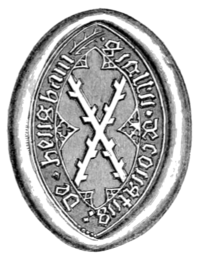opinion, constituted his investiture, by its formal receipt from the diocesan.[1] To the small number, of which Mr. Dansey gives representations, the seal of Pawlett forms an interesting addition.
3. Seal of the Deanery of Hengham. The device is singular, a saltire, or St. Andrew's cross, raguly.—Sigillu . deconatus : de . hengham. In the Taxation of Pope Nicholas IV. is found an ecclesiastical division in the Diocese of London, entitled "Decanatus de Hengham," or Hedingham, comprising Toppesfield, Sible Hedingham, (written Hengham,) and many other parishes in Essex.[2] This is now in the Archdeaconry of Colchester, in the Diocese of Rochester. The rural deanery, to which this seal appertained, was doubtless the "Decanatus de Hengham," in the Diocese of Norwich, which receives its name from the town of Hingham, and comprised forty-three parishes.[3] The church was dedicated to St. Andrew, and this accounts for the device upon the seal. Blomefield gives a list of deans during the fourteenth and fifteenth centuries. This interesting relic is formed of silver, and it is now preserved in the choice cabinet of Norfolk relics, in the possession of Mr. Robert Fitch, of Norwich.
4. Seal of Henry, Abbot of Revesby, Lincolnshire. This is of pointed oval form, measuring 212 inches by 112 inch. The device is the Virgin and infant Saviour; she is seated under a richly crocketed canopy; a sceptre in her hand, a crown of stars, or of flowers, upon her head. The inscription is—Sigillum . henrici abb'is . mon'sterii de . riuesby. The execu- tion is not very artistic; the date may be the latter part of the fifteenth century. The Cluniac Abbey of Revesby was dedicated to St. Mary and St. Lawrence. No abbot named Henry is found in the list given in the new edition of the "Monasticon," (vol. v, p. 453). There is, however, a total hiatus during the fifteenth century.
The matrix was found on the site of Ewenny Priory, Glamorganshire, a cell to Gloucester, and it is in the possession of Colonel Turberville. An impression was produced, with the following seal, by Mr. Franks.
5. Common seal of the Fraternity of the Holy Trinity, Cardiff. A circular seal, of rude execution—diameter, 116 inch. The device is the conventional representation of the Trinity, the Supreme Being seated, and holding a crucifix between his knees. The holy dove descends upon the Saviour's head. S. f'ris trinitatis de kardif in galia. It was found at Llantwit Major, Glamorganshire, and is in the possession of John Nicholl Carne, Esq., LL.D.—Date, fifteenth century.
6. Seal of pointed-oval form, probably the personal seal of an ecclesiastic; the device is the Virgin seated, and holding the infant Jesus. Legend—*AVE MARIA GRACIA PLEN. Date, fourteenth century. The matrix was found amongst the ruins of Reading Abbey, in digging the foundations for the new county prison. It was presented to the Rev. J. Kingrose by the clerk of the works, but was subsequently claimed by the sheriff, and given up.

